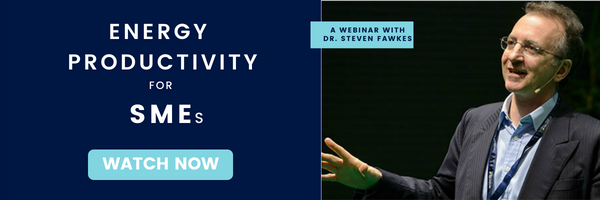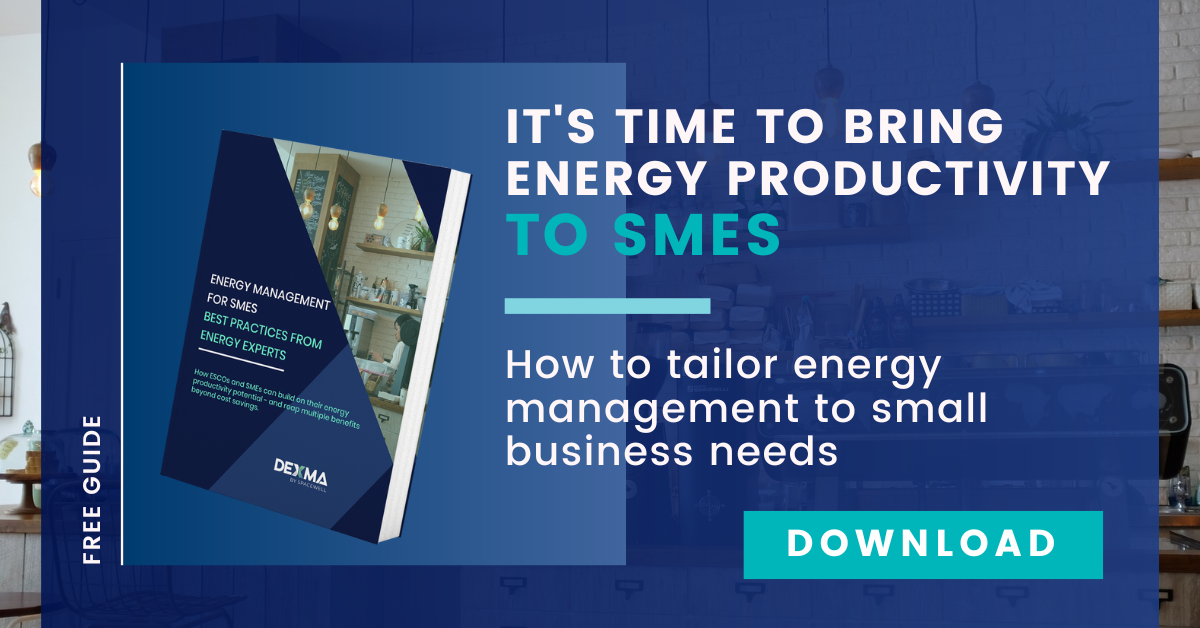Energy efficiency and savings for SMEs sounds nice on paper, but can be much more complicated in practice. Only 5 years ago nearly 40% of European SMEs (more than 7.5 million companies) had not implemented any energy saving or efficiency actions whatsoever.
With the European Commission’s Winter Package proposal for a 30% energy efficiency target by 2030, energy audits targeting SMEs could unlock incredible energy savings potential in Europe. Unfortunately, due to their small size, sectoral variation, and low returns per customer, ESCOs have a particularly difficult time reaching the SME market in order to reach these targets. Yet, if SMEs implemented energy efficiency measures to their full potential, they could shave more than 20% off their energy bills. And that is something SMEs in Europe and beyond simply can’t afford NOT to do.
Most importantly, SMEs have very specific needs when it comes to energy efficiency. ESCOs need to do a better job of recognising and addressing these pain points. To help with that, here is a list of the top energy efficiency challenges faced by small and medium-sized enterprises:
SME Energy Efficiency: Top 10 Pain Points
1. Limited or inaccessible information on Energy Savings Potential
Being able to turn the lights on and power up our computers and office equipment are things we all take for granted when at work. A lot of small to medium-sized businesses are simply too focused on their day-to-day to realise or care how much energy consumption is actually costing them. Or, they lack information about where and how energy is used in their companies. The result? Energy is something SMEs blindly pay for yet feel no real sense of control over.
2. Ain’t nobody got time for that!
SMEs are horrendously overburdened. Since small business owners and executives have so many hats to wear and roles to fill every day, they rarely work “normal” 9-to-5 business hours like the rest of us mere mortals.
Not only do these extra hours drive up energy costs, but it also prevents SMEs from having enough time to explore their energy productivity options. Plus, SMEs rarely view efficiency as a priority, especially during the early development phase. While it’s true that they must maximise efficiency to save money and grow – it’s next to impossible when time is such a scarce resource.
3. No Money to save Money
Despite their big plans to become the Uber of [insert industry here], small business owners rarely have the capital to make their dreams a reality. According to Forbes, only about 32% of respondents from a small business survey were able to satisfy their needs when it came to borrowing capital. This might seem like a double-edged sword for SMEs that are desperately trying to optimise for efficiency.
One reason for SMEs’ limited access to capital is usually caused by an insufficient capacity to develop “bankable” projects with an ROI that is comfortable enough for financial institutions to lend them money. Or, banks might lack financial products or the capacity to deal with the particular needs of SME energy efficiency.
It’s no wonder that energy management is often dismissed as too big a strain on SME resources! Without adequate financial support, energy management is considered money better spent on expanding business the old-fashioned way.
4. The SME Invisibility Cloak
While large, energy-intensive industries tend to benefit significantly from government energy efficiency programs, SMEs tend to receive very limited support. Their energy use and energy savings potential go largely unnoticed by ESCOs and governments.
Although some public programmes are in operation to help SMEs realise energy efficiency savings, they tend to be small in scope and have a very limited duration. When changes in governments happen, these programmes are hardly ever continued, replicated or scaled up to assist larger numbers of SMEs. The pace of change can be dizzying, and SMEs do not have the time or resources to keep up with legislative changes. ESCOs, therefore, have a unique role to play in helping SMEs navigate this dynamic landscape. They can also assist governments with the challenge of reaching more SMEs with diverse energy needs, operating in different sectors.
5. Lack of trust when it comes to Energy Services procurement
“There is a long arc to build trust in this industry”, says Jessica Stromback, Chairman of financial services company Joule Assets Europe and coordinator of the Sustainable Energy Asset Framework. Antonio Ciccarelli, CEO of Italian energy services company Servizi Energia Ambiente, agrees: “The most complicated thing is trust. [ESCOs] are selling savings, but how does the customer know if they can trust you to deliver on them?”
ESCOs have to go the extra mile to build a trust-based relationship with their SME clients, who are wary of being taken advantage of. Transparency of energy-relevant data is the key to raising awareness and building the trust needed to generate real energy savings. Energy efficiency actions can only be motivated by SMEs if transaction costs for collecting such data are reduced to nearly zero. Gaining the trust of SMEs is a long process, so be patient!
6. Understanding Energy Consumption
Hardly anyone can understand their electricity bill, but you can’t manage what you can’t measure! It’s essential for SMEs to understand how they consume energy before they can start saving it. Plus, a recent study by Inenco found that 1 in 5 energy bills have errors on them that businesses frequently overlook. In fact, 80% of businesses (in the UK) do not conduct regular invoice validation and bill audits – resulting in a collective loss of £500m.
7. Doubts around actual savings potential
It is to be expected that SMEs will have doubts when it comes to their savings potential. Questions like “How much can I actually save?” or “Is it REALLY worth it to invest in saving energy?” or “Am I more or less efficient compared to businesses like mine?” are bound to come up. A trustworthy ESCO must be prepared to answer these questions with clear, concise responses – and the data to back them up.
Some SMEs are actually ready and willing to start energy efficiency projects – which is great news for ESCOs! But most have no idea where to start looking for financing. Reluctant (or unable) to use their own resources, SMEs are the perfect candidates for third-party financing… if only they knew where to look or had time to apply! That’s where you come in, dear ESCO…




